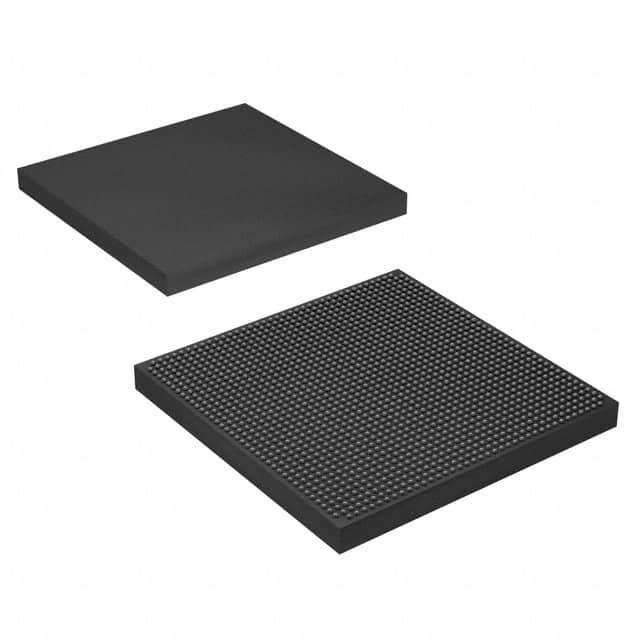Viz Specifikace pro podrobnosti o produktu.

5SGXEA7N1F40C2
Product Overview
Category
The 5SGXEA7N1F40C2 belongs to the category of Field Programmable Gate Arrays (FPGAs).
Use
This FPGA is designed for high-performance applications that require complex digital logic circuits. It provides a flexible and reconfigurable hardware platform for various electronic systems.
Characteristics
- High-speed processing capabilities
- Large number of programmable logic elements
- On-chip memory resources
- Support for various communication protocols
- Low power consumption
- High reliability and durability
Package
The 5SGXEA7N1F40C2 comes in a compact package, which ensures easy integration into electronic systems. The package includes the FPGA chip, as well as necessary connectors and pins for external connections.
Essence
The essence of the 5SGXEA7N1F40C2 lies in its ability to implement complex digital logic circuits through programming. It allows users to create custom hardware designs without the need for dedicated integrated circuits.
Packaging/Quantity
The 5SGXEA7N1F40C2 is typically sold individually or in small quantities, depending on the requirements of the user or project.
Specifications
- Logic Elements: 1,150,000
- Embedded Memory: 53,248 Kbits
- Maximum User I/Os: 1,280
- DSP Blocks: 3,888
- Clock Networks: 16
- Maximum Operating Frequency: 500 MHz
- Voltage Range: 0.87V - 0.93V
Detailed Pin Configuration
The pin configuration of the 5SGXEA7N1F40C2 is as follows:
- Pin 1: VCCIO
- Pin 2: GND
- Pin 3: VCCINT
- Pin 4: GND
- Pin 5: IO1A
- Pin 6: IO1B
- ...
- Pin 1279: IO640A
- Pin 1280: IO640B
Functional Features
The 5SGXEA7N1F40C2 offers the following functional features:
- High-speed data processing capabilities
- Support for various communication protocols (e.g., PCIe, Ethernet)
- On-chip memory resources for efficient data storage and retrieval
- Flexible I/O options for interfacing with external devices
- Built-in digital signal processing blocks for complex mathematical operations
- Configurable clock networks for precise timing control
Advantages and Disadvantages
Advantages
- Flexibility in hardware design due to programmability
- High-performance computing capabilities
- Low power consumption compared to dedicated integrated circuits
- Reconfigurability allows for iterative development and testing
- Cost-effective solution for prototyping and small-scale production
Disadvantages
- Steeper learning curve compared to traditional hardware design methods
- Limited resource availability compared to application-specific integrated circuits (ASICs)
- Higher cost per unit compared to mass-produced ASICs for large-scale production
Working Principles
The 5SGXEA7N1F40C2 operates based on the principles of reconfigurable logic. It consists of a matrix of programmable logic elements interconnected by configurable routing resources. The user programs the FPGA using a Hardware Description Language (HDL) to define the desired functionality. Upon configuration, the FPGA executes the programmed logic, enabling the implementation of complex digital systems.
Detailed Application Field Plans
The 5SGXEA7N1F40C2 finds applications in various fields, including:
- Telecommunications: Used in base stations, routers, and network switches for high-speed data processing and protocol handling.
- Aerospace and Defense: Employed in radar systems, avionics, and military communication equipment for real-time signal processing and data encryption.
- Industrial Automation: Utilized in control systems, robotics, and machine vision applications for high-speed data acquisition and processing.
- Medical Devices: Integrated into medical imaging systems, patient monitoring devices, and diagnostic equipment for real-time data analysis and image processing.
- Automotive: Used in advanced driver-assistance systems (ADAS), infotainment systems, and engine control units (ECUs) for efficient data processing and control.
Detailed and Complete Alternative Models
- 5SGXEA7N2F40C2
- 5SGXEA7N3F40C2
- 5SGXEA7N4F40C2
- 5SGXEA7N5F40C2
- 5SGXEA7N6F40C2
These alternative models offer similar features and capabilities to the 5SGXEA7N1F40C2 but may differ in terms of logic elements, embedded
Seznam 10 běžných otázek a odpovědí souvisejících s aplikací 5SGXEA7N1F40C2 v technických řešeních
Sure! Here are 10 common questions and answers related to the application of 5SGXEA7N1F40C2 in technical solutions:
1. What is the 5SGXEA7N1F40C2 FPGA used for? The 5SGXEA7N1F40C2 FPGA is a high-performance field-programmable gate array (FPGA) that can be used in various applications such as telecommunications, data centers, industrial automation, and aerospace.
2. What are the key features of the 5SGXEA7N1F40C2 FPGA? Some key features of the 5SGXEA7N1F40C2 FPGA include high logic density, high-speed transceivers, embedded memory blocks, DSP capabilities, and support for various I/O standards.
3. Can the 5SGXEA7N1F40C2 FPGA handle high-speed data processing? Yes, the 5SGXEA7N1F40C2 FPGA is designed to handle high-speed data processing with its high-speed transceivers and advanced architecture.
4. How can the 5SGXEA7N1F40C2 FPGA be programmed? The 5SGXEA7N1F40C2 FPGA can be programmed using hardware description languages (HDLs) such as VHDL or Verilog, or through graphical programming tools like Quartus Prime.
5. Does the 5SGXEA7N1F40C2 FPGA support PCIe connectivity? Yes, the 5SGXEA7N1F40C2 FPGA supports PCIe connectivity, making it suitable for applications requiring high-speed data transfer between devices.
6. Can the 5SGXEA7N1F40C2 FPGA be used for real-time signal processing? Yes, the 5SGXEA7N1F40C2 FPGA is capable of real-time signal processing due to its high-performance architecture and embedded digital signal processing (DSP) capabilities.
7. What are the power requirements for the 5SGXEA7N1F40C2 FPGA? The power requirements for the 5SGXEA7N1F40C2 FPGA can vary depending on the specific application, but typically it operates at a voltage range of 0.9V to 1.1V.
8. Can the 5SGXEA7N1F40C2 FPGA be used in safety-critical applications? Yes, the 5SGXEA7N1F40C2 FPGA can be used in safety-critical applications as long as proper design practices and redundancy measures are implemented to ensure reliability.
9. Does the 5SGXEA7N1F40C2 FPGA support encryption and security features? Yes, the 5SGXEA7N1F40C2 FPGA provides built-in encryption and security features to protect sensitive data and intellectual property.
10. Are there any development kits available for the 5SGXEA7N1F40C2 FPGA? Yes, Intel (formerly Altera) offers development kits specifically designed for the 5SGXEA7N1F40C2 FPGA, providing a comprehensive platform for prototyping and testing applications.
Please note that the answers provided here are general and may vary based on specific implementation requirements.

